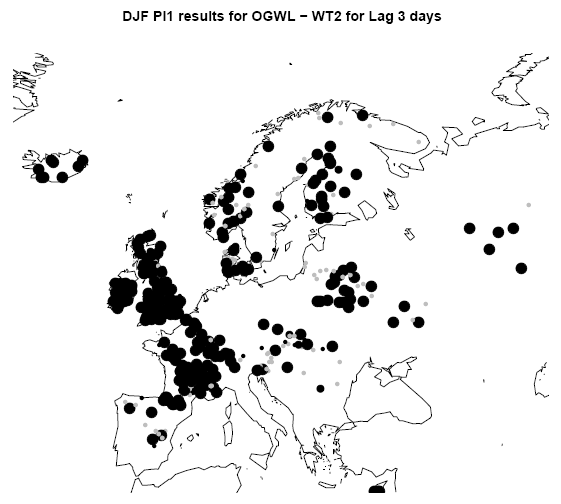|
|
|
| |
| |

The main task of Workgroup 4 (WG4) in COST 733 implies the testing of the selected weather type methods for various classifications. In more detail, WG4 focuses on the following topics:
In order to address these specific aims, various applications are selected and WG4 is divided in subgroups accordingly:
1.Air quality
2. Hydrology (& Climatological mapping)
3. Forest fires
4. Climate change and variability
5. Risks and hazards
Simultaneously, special attention is paid to the several wide topics concerning some other COST Actions such as: phenology (COST725), biometeorology (COST730), agriculture (COST 734) and mesoscale modelling and air pollution (COST728). Sub-groups are established to find advantages and disadvantages of different classification methods for different applications. Focus is given to data requirements, spatial and temporal scale, domain area, specific methodology etc. This will end up in requirements for a general classification method. Furthermore, some overlap is occurring with the activities of Working Group 3, which compares the methods themselves, although often use is made of the synoptic/surface meteorological variables (precipitation, temperature…).
A short summery of each WG4 subgroup is given below. For further information, please contact the respective members of each subgroup.
1. Air quality
Members: M. Demuzere, S. Stefan, J. Godlowska, A.M. Tomaszewska, M. Bogucka,
The following activities are undertaken by colleagues from Belgium, Romania and Poland:
Members: A. Fleig, C. Prudhomme, R. Schiemann, L. Tallaksen
Members of Switzerland, Norway, UK are dealing with the following topics:
Flood occurrence
Data from over 400 European rivers are used to define floods in terms of the peak-over-threshold method. Thereby, links between the derived flood indices and weather types occurrences during and prior (persistence) to the event are investigated. As an example, the hypothesis “is a circulation type occurring more frequently during a flood event than usual?” is tested in Figure 1.

Figure 1: Illustration of the hypothesis tested for winter for two circulation types of the objective Hess-Brezowsky classification (OGWL) derived from ERA-40 re-analyses. For the great majority of stations analysed, circulation type 2 occurs in winter more often 3 days before a flood event than on any other days.
Hydrological drought
Stream flow deficits are used to define time series of hydrological drought in Great Britain and Denmark. Groups of weather types that support drought development are identified and correlations between the occurrence frequencies of these groups and both daily and seasonal drought series are computed
Precipitation mapping
Reduced-space optimal interpolation (RSOI) is used for quasi real-time precipitation mapping over Switzerland. The evaluation of maps obtained by (i) RSOI stratified with respect to weather types and (ii) unstratified RSOI shows that the added value due to weather-type information depends strongly on the weather type.
Members: P. Kassomenos, M. Erpicum, D. Rasilla, R. Trigo
A rather large subgroup from Belgium, Portugal, Greece and Spain are dealing with forest/bush fires in the above-mentioned regions. Hereby, circulation patterns are used to identify the explanatory/predictable power of the classifications on forest fires. For e.g., P. Kavlomenos has shown during the mid-term conference in Krakow that “The application of some of the selected COST weather types catalogues on forest fire event shows that even if we use the short 3-days sequences of the weather types the number of weather types that are associated with wild fires is reduced significantly. From the chosen catalogues SANDRA and PCAXTR it was found that 2 categories, out of 8, account for almost 80-90% of the total wild fires events in Greece. On the other hand the Kirchhofer catalogue is not very successful since wild fire events are almost evenly dispersed among the categories.”
The work proved that the hypothesis of using synoptic classifications to study and possibly predict wild fires events, in a way similar to air pollution episodes and mortality levels, is justifiable, but a lot of work must be done to make it more easily applicable by the authorities in order to protect people and their belongings.
Members: M. Cahynova, M.A. Pastor, M.J. Casado, K. Pianko-Kluczynska, Z. Ustrnul
The main objectives of this subgroup (including Spain, Czech republic) include:
Persistence (lifetime) of circulation types over Europe and four specific European domains in 1957–2002.
Links between
atmospheric circulation classifications and climatic variability and trends in
the Czech Republic in 1961–1998, including:![]()
ranking
of circulation classifications according to their ability to stratify eleven
climatic elements into circulation types.
![]()
influence of changes in circulation types frequencies on seasonal climatic
trends.
Figure 2: Spatial STD distribution of the precipitation percentage for the three sub-catalogues of the PETISCO classification (click on images to enlarge)
![]()





 Members:
L. Latinov, R. Bertalanic, D. Nikolov, F. Georgescu
Members:
L. Latinov, R. Bertalanic, D. Nikolov, F. Georgescu
Copyright 2008-2010 COST Action 733.
Contacts:
ole.einar.tveito@met.no
Last updated:
11.01.11.
Copyright 2008-2010 COST Action 733.
Contacts:
ole.einar.tveito@met.no
Last updated:
23.04.13.
|
|